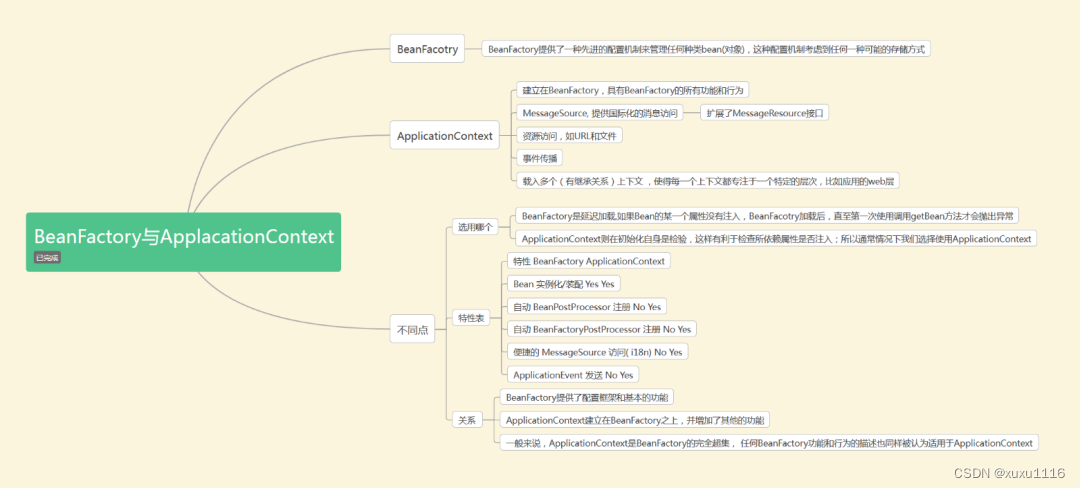面试题:Spring 中获取 Bean 的方式有哪些?
文章目录
- 前言
- 1、在初始化时保存ApplicationContext对象
- 2、通过Spring提供的工具类获取ApplicationContext对象
- 3、实现接口ApplicationContextAware(推荐)
- 4、继承自抽象类ApplicationObjectSupport
- 5、继承自抽象类WebApplicationObjectSupport
- 6、使用BeanFactory直接获取(不推荐)
- 7、使用ContextLoader提供的getCurrentWebApplicationContext方法
- 8、实现接口BeanFactoryPostProcessor
- 扩展
- BeanFactory
- ApplicationContext
前言

1、在初始化时保存ApplicationContext对象
适用于Spring框架的独立应用程序,须要程序通过配置文件初始化Spring。
applicationContext.xml配置:
<?xml version="1.0" encoding="UTF-8"?>
<beans xmlns="http://www.springframework.org/schema/beans"
xmlns:xsi="http://www.w3.org/2001/XMLSchema-instance"
xmlns:p="http://www.springframework.org/schema/p"
xsi:schemaLocation="http://www.springframework.org/schema/beans http://www.springframework.org/schema/beans/spring-beans.xsd">
<bean id="test" class="com.sxtx.bean.Test">
</bean>
</beans>
代码:
@Test
public void test() {
ApplicationContext applicationContext = new ClassPathXmlApplicationContext("applicationContext.xml");
//ApplicationContext applicationContext = new FileSystemXmlApplicationContext("applicationContext.xml");
Test test= (Test) applicationContext.getBean("test");
System.out.println(test);
}
2、通过Spring提供的工具类获取ApplicationContext对象
适合于Spring框架的B/S系统,通过ServletContext对象获取ApplicationContext对象。然后在通过它获取须要的类实例。以下两个工具方式的差别是,前者在获取失败时抛出异常。后者返回null。
ApplicationContext ac1 = WebApplicationContextUtils.getRequiredWebApplicationContext(ServletContext sc);
ApplicationContext ac2 = WebApplicationContextUtils.getWebApplicationContext(ServletContext sc);
ac1.getBean("beanId");
ac2.getBean("beanId");
3、实现接口ApplicationContextAware(推荐)
实现该接口的setApplicationContext(ApplicationContext context)方法,并保存ApplicationContext 对象。Spring初始化时,扫描到该类,就会通过该方法将ApplicationContext对象注入。然后在代码中就可以获取spring容器bean了。
例如:
User bean = SpringUtils.getBean(“user”);
@Component
public class SpringUtils implements ApplicationContextAware {
private static ApplicationContext applicationContext;
@Override
public void setApplicationContext(ApplicationContext applicationContext) throws BeansException {
SpringUtils.applicationContext = applicationContext;
}
public static <T> T getBean(String beanName) {
if(applicationContext.containsBean(beanName)){
return (T) applicationContext.getBean(beanName);
}else{
return null;
}
}
public static <T> Map<String, T> getBeansOfType(Class<T> baseType){
return applicationContext.getBeansOfType(baseType);
}
}
4、继承自抽象类ApplicationObjectSupport
调用父类的getApplicationContext()方法,获取Spring容器对象。
@Service
public class SpringContextHelper extends ApplicationObjectSupport {
public Object getBean(String beanName) {
return getApplicationContext().getBean(beanName);
}
}
5、继承自抽象类WebApplicationObjectSupport
调用getWebApplicationContext()获取WebApplicationContext
@Service
public class SpringContextHelper extends WebApplicationObjectSupport {
public Object getBean(String beanName) {
return getApplicationContext().getBean(beanName);
}
}
6、使用BeanFactory直接获取(不推荐)
使用BeanFactory从工厂中直接获取Bean实例,但是XmlBeanFactory类已经废弃,因此不建议使用。
@Test
public void test() {
BeanFactory beanFactory = new XmlBeanFactory(new ClassPathResource("applicationContext.xml"));
Test test= (Test) beanFactory.getBean("test");
System.out.println(test);
}
7、使用ContextLoader提供的getCurrentWebApplicationContext方法
@Test
public void test() {
MockServletContext sc = new MockServletContext("");
sc.addInitParameter(ContextLoader.CONFIG_LOCATION_PARAM, "/applicationContext.xml");
ServletContextListener listener = new ContextLoaderListener();
ServletContextEvent event = new ServletContextEvent(sc);
listener.contextInitialized(event);
WebApplicationContext wac = ContextLoader.getCurrentWebApplicationContext();
Test test= (Test) wac.getBean("test");
System.out.println(test);
}
8、实现接口BeanFactoryPostProcessor
spring工具类 方便在非spring管理环境中获取bean
@Component
public final class SpringUtilsS implements BeanFactoryPostProcessor
{
/** Spring应用上下文环境 */
private static ConfigurableListableBeanFactory beanFactory;
@Override
public void postProcessBeanFactory(ConfigurableListableBeanFactory beanFactory) throws BeansException
{
SpringUtilsS.beanFactory = beanFactory;
}
/**
* 获取对象
*
* @param name
* @return Object 一个以所给名字注册的bean的实例
* @throws BeansException
*
*/
@SuppressWarnings("unchecked")
public static <T> T getBean(String name) throws BeansException
{
return (T) beanFactory.getBean(name);
}
/**
* 获取类型为requiredType的对象
*
* @param clz
* @return
* @throws BeansException
*
*/
public static <T> T getBean(Class<T> clz) throws BeansException
{
T result = (T) beanFactory.getBean(clz);
return result;
}
/**
* 如果BeanFactory包含一个与所给名称匹配的bean定义,则返回true
*
* @param name
* @return boolean
*/
public static boolean containsBean(String name)
{
return beanFactory.containsBean(name);
}
/**
* 判断以给定名字注册的bean定义是一个singleton还是一个prototype。 如果与给定名字相应的bean定义没有被找到,将会抛出一个异常(NoSuchBeanDefinitionException)
*
* @param name
* @return boolean
* @throws NoSuchBeanDefinitionException
*
*/
public static boolean isSingleton(String name) throws NoSuchBeanDefinitionException
{
return beanFactory.isSingleton(name);
}
/**
* @param name
* @return Class 注册对象的类型
* @throws NoSuchBeanDefinitionException
*
*/
public static Class<?> getType(String name) throws NoSuchBeanDefinitionException
{
return beanFactory.getType(name);
}
/**
* 如果给定的bean名字在bean定义中有别名,则返回这些别名
*
* @param name
* @return
* @throws NoSuchBeanDefinitionException
*
*/
public static String[] getAliases(String name) throws NoSuchBeanDefinitionException
{
return beanFactory.getAliases(name);
}
/**
* 获取aop代理对象
*
* @param invoker
* @return
*/
@SuppressWarnings("unchecked")
public static <T> T getAopProxy(T invoker)
{
return (T) AopContext.currentProxy();
}
}
扩展
BeanFactory和ApplicationContext是Spring的两大核心接口,都可以当做Spring的容器。其中ApplicationContext是BeanFactory的子接口。
BeanFactory
(1)、是Spring里面最底层的接口(最原始的接口),包含了各种Bean的定义,读取bean配置文档,管理bean的加载、实例化,控制bean的生命周期,维护bean之间的依赖关系。
(2)、采用的是延迟加载形式来注入Bean的,即只有在使用到某个Bean时(调用getBean()),才对该Bean进行加载实例化。这样,我们就不能发现一些存在的Spring的配置问题。如果Bean的某一个属性没有注入,BeanFacotry加载后,直至第一次使用调用getBean方法才会抛出异常。
(3)BeanFactory通常以编程的方式被创建。
(4)BeanFactory和ApplicationContext都支持BeanPostProcessor、BeanFactoryPostProcessor的使用,但两者之间的区别是:BeanFactory需要手动注册,而ApplicationContext则是自动注册。
(5) 占用内存小。
ApplicationContext
1、ApplicationContext接口作为BeanFactory的派生,除了提供BeanFactory所具有的功能外,还提供了更完整的框架功能:
- 继承MessageSource,因此支持国际化。
- 统一的资源文件访问方式。
- 提供在监听器中注册bean的事件。
- 同时加载多个配置文件。
- 载入多个(有继承关系)上下文 ,使得每一个上下文都专注于一个特定的层次,比如应用的web层。
2、ApplicationContext,它是在容器启动时,一次性创建了所有的Bean。这样,在容器启动时,我们就可以发现Spring中存在的配置错误,这样有利于检查所依赖属性是否注入。ApplicationContext启动后预载入所有的单实例Bean,通过预载入单实例bean ,确保当你需要的时候,你就不用等待,因为它们已经创建好了。
3、ApplicationContext 占用内存空间大,当程序的配置bean特别多时,程序启动慢。
4、ApplicationContext 能以编程式方式创建,还能能以声明的方式创建,如使用ContextLoader。
